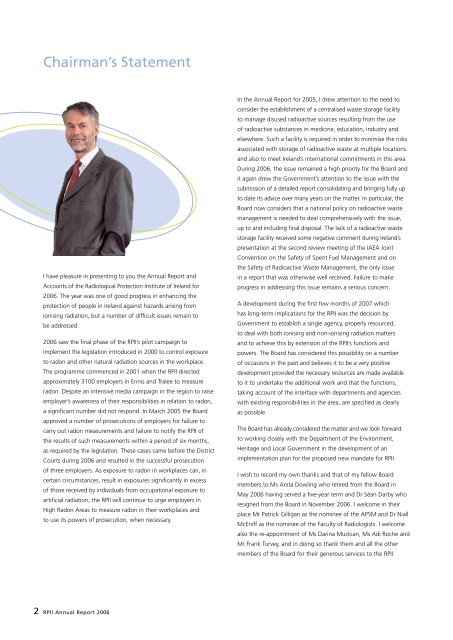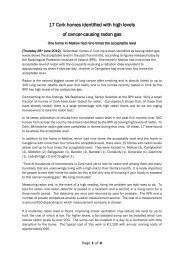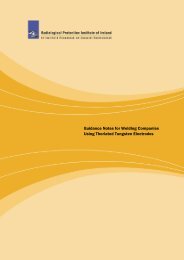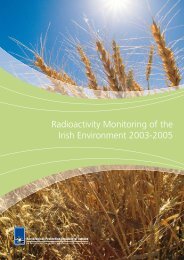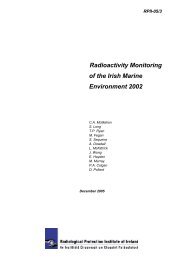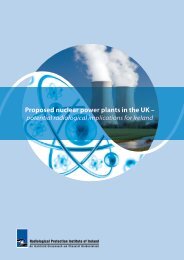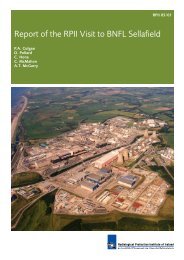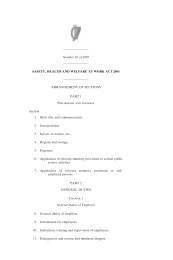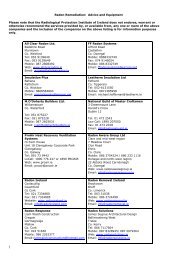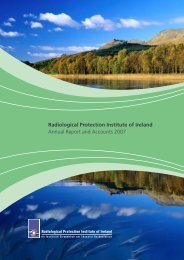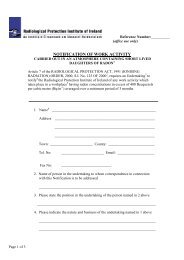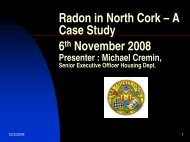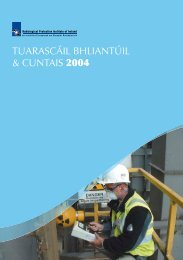Annual Report and Accounts 2006 - Radiological Protection Institute ...
Annual Report and Accounts 2006 - Radiological Protection Institute ...
Annual Report and Accounts 2006 - Radiological Protection Institute ...
You also want an ePaper? Increase the reach of your titles
YUMPU automatically turns print PDFs into web optimized ePapers that Google loves.
Chairman’s Statement<br />
I have pleasure in presenting to you the <strong>Annual</strong> <strong>Report</strong> <strong>and</strong><br />
<strong>Accounts</strong> of the <strong>Radiological</strong> <strong>Protection</strong> <strong>Institute</strong> of Irel<strong>and</strong> for<br />
<strong>2006</strong>. The year was one of good progress in enhancing the<br />
protection of people in Irel<strong>and</strong> against hazards arising from<br />
ionising radiation, but a number of difficult issues remain to<br />
be addressed.<br />
<strong>2006</strong> saw the final phase of the RPII’s pilot campaign to<br />
implement the legislation introduced in 2000 to control exposure<br />
to radon <strong>and</strong> other natural radiation sources in the workplace.<br />
The programme commenced in 2001 when the RPII directed<br />
approximately 3100 employers in Ennis <strong>and</strong> Tralee to measure<br />
radon. Despite an intensive media campaign in the region to raise<br />
employer’s awareness of their responsibilities in relation to radon,<br />
a significant number did not respond. In March 2005 the Board<br />
approved a number of prosecutions of employers for failure to<br />
carry out radon measurements <strong>and</strong> failure to notify the RPII of<br />
the results of such measurements within a period of six months,<br />
as required by the legislation. These cases came before the District<br />
Courts during <strong>2006</strong> <strong>and</strong> resulted in the successful prosecution<br />
of three employers. As exposure to radon in workplaces can, in<br />
certain circumstances, result in exposures significantly in excess<br />
of those received by individuals from occupational exposure to<br />
artificial radiation, the RPII will continue to urge employers in<br />
High Radon Areas to measure radon in their workplaces <strong>and</strong><br />
to use its powers of prosecution, when necessary.<br />
In the <strong>Annual</strong> <strong>Report</strong> for 2005, I drew attention to the need to<br />
consider the establishment of a centralised waste storage facility<br />
to manage disused radioactive sources resulting from the use<br />
of radioactive substances in medicine, education, industry <strong>and</strong><br />
elsewhere. Such a facility is required in order to minimise the risks<br />
associated with storage of radioactive waste at multiple locations<br />
<strong>and</strong> also to meet Irel<strong>and</strong>’s international commitments in this area.<br />
During <strong>2006</strong>, the issue remained a high priority for the Board <strong>and</strong><br />
it again drew the Government’s attention to the issue with the<br />
submission of a detailed report consolidating <strong>and</strong> bringing fully up<br />
to date its advice over many years on the matter. In particular, the<br />
Board now considers that a national policy on radioactive waste<br />
management is needed to deal comprehensively with the issue,<br />
up to <strong>and</strong> including final disposal. The lack of a radioactive waste<br />
storage facility received some negative comment during Irel<strong>and</strong>’s<br />
presentation at the second review meeting of the IAEA Joint<br />
Convention on the Safety of Spent Fuel Management <strong>and</strong> on<br />
the Safety of Radioactive Waste Management, the only issue<br />
in a report that was otherwise well received. Failure to make<br />
progress in addressing this issue remains a serious concern.<br />
A development during the first few months of 2007 which<br />
has long-term implications for the RPII was the decision by<br />
Government to establish a single agency, properly resourced,<br />
to deal with both ionising <strong>and</strong> non-ionising radiation matters<br />
<strong>and</strong> to achieve this by extension of the RPII’s functions <strong>and</strong><br />
powers. The Board has considered this possibility on a number<br />
of occasions in the past <strong>and</strong> believes it to be a very positive<br />
development provided the necessary resources are made available<br />
to it to undertake the additional work <strong>and</strong> that the functions,<br />
taking account of the interface with departments <strong>and</strong> agencies<br />
with existing responsibilities in the area, are specified as clearly<br />
as possible.<br />
The Board has already considered the matter <strong>and</strong> we look forward<br />
to working closely with the Department of the Environment,<br />
Heritage <strong>and</strong> Local Government in the development of an<br />
implementation plan for the proposed new m<strong>and</strong>ate for RPII.<br />
I wish to record my own thanks <strong>and</strong> that of my fellow Board<br />
members to Ms Anita Dowling who retired from the Board in<br />
May <strong>2006</strong> having served a five-year term <strong>and</strong> Dr Séan Darby who<br />
resigned from the Board in November <strong>2006</strong>. I welcome in their<br />
place Mr Patrick Gilligan as the nominee of the APSM <strong>and</strong> Dr Niall<br />
McEniff as the nominee of the Faculty of Radiologists. I welcome<br />
also the re-appointment of Ms Darina Muckian, Ms Adi Roche <strong>and</strong><br />
Mr Frank Turvey, <strong>and</strong> in doing so thank them <strong>and</strong> all the other<br />
members of the Board for their generous services to the RPII.<br />
RPII <strong>Annual</strong> <strong>Report</strong> <strong>2006</strong>


